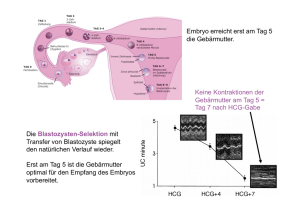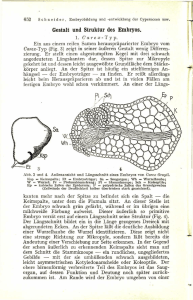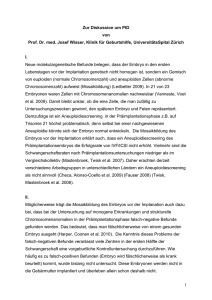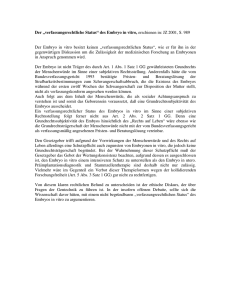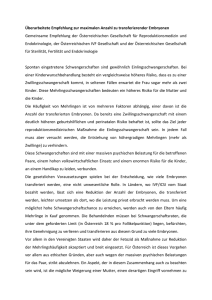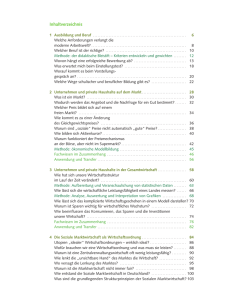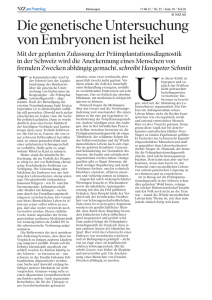Sinn des Blastozystentransfers - green-ivf
Werbung
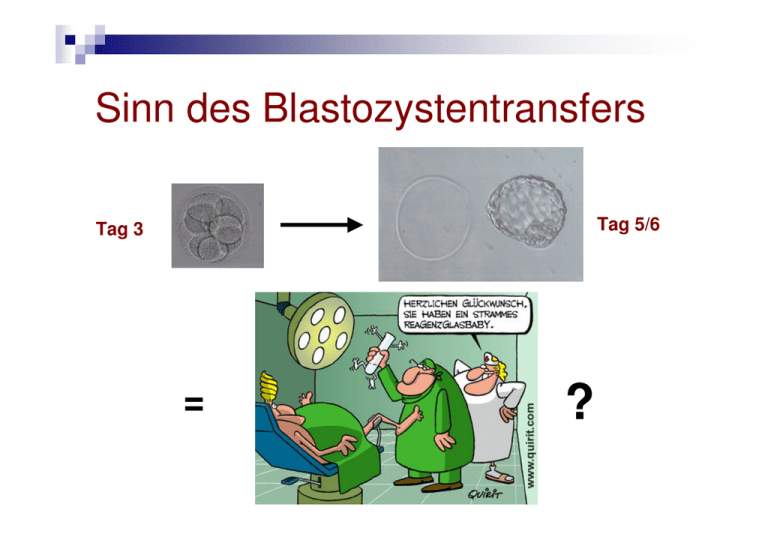
Sinn des Blastozystentransfers Tag 5/6 Tag 3 = ? Sinn des Blastozystentransfers Sinn des Blastozystentransfers Gardner et al. 1998, Human Reproduction13, 3434-3440: Reducing the risk of multiple gestations while maintaining high pregnancy rates - by development of sequential, serum-free media routinely which allows culture of human embryos in vitro until day 5 or 6 after retrieval (glucose → pyruvate) - by transfer of embryos on day 5 which results in significantly higher implantation rates than transfer on day 3 (50,5% vs. 30,1%) - by transferring blastocysts rather than day-3-embryos the number of embryos per transfer can be significantly reduced without negatively affecting the pregnancy rate Sinn des Blastozystentransfers Kolibianakis and Devroey Reproductive Biomedicine Online, 2002, 5, 285-293: Blastocystformation rate: 21 –58% Cycle cancellation rate: 4.5 –11% Sinn des Blastozystentransfers Pregnancy outcome after blastocyst transfer as compared to early cleavage stage embryo transfer. Schwarzler P, Zech H, Auer M, Pfau K, Gobel G, Vanderzwalmen P, Zech N Hum Reprod. 2004 Sep;19(9):2097-10 „Our data suggest that blastocyst transfer may lead to a higher pregnancy rate with an overall better take-home baby rate (THBR) at the cost of higher rates of multiples and preterm deliveries.“ Sinn des Blastozystentransfers Should we advise patients undergoing IVF to start a cycle leading to a day 3 or a day 5 transfer? Kolibianakis EM, Zikopoulos K, Verpoest W, Camus M, Joris H, Van Steirteghem AC, Devroey P Hum Reprod. 2004 Nov;19(11):2550-4 „Advising patients at consultation to initiate an IVF cycle leading to a day 5 as compared with a day 3 transfer does not appear to increase the probability of ongoing pregnancy, and is associated with a significantly lower probability of obtaining cryopreserved embryos.“ Sinn des Blastozystentransfers Early cleavage is a valuable addition to existing embryo selection parameters: a study using single embryo transfers. Van Montfoort AP, Dumoulin JC, Kester AD, Evers JL. Hum Reprod. 2004 Sep;19(9):2103-8 „To reduce the twin pregnancy rate, elective single embryo transfer (eSET) is increasingly implemented. Improvement of the results obtained with eSET can be achieved by better selection of the most viable embryo ….In order to improve the selection of the embryo with the highest implantation potential, selection for transfer should not be based on cell number and morphology on the day of transfer alone, but also on early cleavage status.“ The merits of blastocyst versus cleavage stage embryo transfer: a Cochrane review (HR 9/2004) Blake DA, Proctor M, Johnson NP National Women's Hospital, Auckland Fourteen randomized controlled trials, all comparing day 2/3 with day 5/6 embryo transfer, were included in a meta-analysis. For day 2/3 versus day 5/6 transfer, there was no significant difference in the odds of pregnancy [odds ratio (OR) = 0.91, 95% confidence interval (CI) 0.71-1.17] nor of live birth (OR = 0.83, 95% CI 0.48-1.42) per treated couple. The results were similar whether all trials, only trials with transfer of equal numbers of day 2/3 versus day 5/6, or only trials with transfer of fewer day 5/6 than day 2/3 embryos, were pooled. The current evidence fails to support a widespread change of practice from cleavage stage to blastocyst stage embryo transfer in couples undergoing IVF. Sinn des Blastozystentransfers Interpretation: Selektion Tag 3 ist ähnlich gut möglich wie Selektion Tag 5/6 Alter: für viele Patienten (Hauptklientel !) kein Vorteil, da nur wenig Befruchtungen und zu wenig Achtzeller am Tag 3 (min. 8-10 Oozyten für 2 BZ) Transferpolitik in retrospektiven Studien (BZ-Transfer bevorzugt bei schlechter Prognose) Begrenzte Aussagekraft morphologischer Kriterien zur Blastozystenselektion Vorteil nur bei jungen Patientinnen mit geplantem „single embryo transfer, SET“ Fragl. Vorteil im Vergleich mit kumulativen Ss-Raten (frische ET´s + KryoET´s) Sinn des Blastozystentransfers Diedrich, Klaus; Griesinger, Georg; Behre, Hermann M.; Felberbaum, Ricardo; Montag, Markus; Ven, Hans-Hermann van der; Strowitzki, Thomas; Otte, Sören von Neue Entwicklungen in der Reproduktionsmedizin Sinn des Blastozystentransfers Allgemeine Nachteile: Höheres Risiko von imprinting failures ? Altersabhängige Blastulationsrate Eingeschränkte Möglichkeit von assisted hatching Eingeschränkte Aussagekraft der Blastozystenmorphologie Auch ~ 50% schöner Blastozysten sind chromosomal aberrant Probleme bei der Kryokonservierung Höhere Kosten Spezielle Medien Personalkosten (Umsetzten der Embryonen) Kein ET (Beratung) Missverständliche Deutung des Blastozystentransfersdurch Pat. und Kollegen Sinn des Blastozystentransfers Unter den Bedingungen des Embryonenschutzgesetztes bedeutet die Möglichkeit eines Blastozystentransfers: Keinen Vorteil der längeren In-vitro-Kultur an sich (außer: Verschieben des ETTermins möglich, z.B. Wochenende) Einen deutschen Nachteil bei wünschenswertem SET bei sehr jungen Patientinnen (Keine Selektion, Aufhebung der Dreier-Regel nötig) Trotzdem nötigen elektiven ET (PN-Scoring, da Aneuploidierate auch schöner Blastozysten bis 50%) Fragen bei zukünftig vielleicht auch hier möglichem Blastozystentransfer nach Selektion: Wie ändern sich die Ss-Raten? Wie sieht es im internationalen Vergleich aus? Wie sehen kumulative Ss-Raten aus?

